 German Empire (1897) Heavy cruiser
German Empire (1897) Heavy cruiser WW1 German Cruisers
Irene class | SMS Gefion | SMS Hela | SMS Kaiserin Augusta | Victoria Louise class | Prinz Adalbert class | SMS Prinz Heinrich | SMS Fürst Bismarck | Roon class | Scharnhorst class | SMS BlücherBussard class | Gazelle class | Bremen class | Kolberg class | Königsberg class | Nautilus class | Magdeburg class | Dresden class | Graudenz class | Karlsruhe class | Pillau class | Wiesbaden class | Karlsruhe class | Brummer class | Königsberg ii class | Cöln class
The Kaiser’s first heavy cruiser:
The Fürst Bismarck (“Prince Bismarck”) named after the Chancellor and statesman which unified Germany in 1870, was also the name of the first “Großer Kreuzer, 2nd Klasse”, the first German heavy cruiser. Why “heavy” and not “armoured cruiser” ? Previous denominations of German cruisers had been hectic, notably the “aviso-cruisers” or “cruiser-corvettes” of the 1880-90s. It came from a lineage started in the Frigates and corvettes of the late 1870s, masted aviso-cruisers of the 1880s and the first modern armoured cruiser, SMS Kaiserin Augusta, followed by the five ships of the Victoria Luise class. See the complete lineage of German cruisers in WW1. She should have been the lead ship of a class of five more armoured cruisers but another direction was taken, towards far larger cruisers, and thus individual ships, the Fürst Bismarck launched in 1897, and the Prinz Heinrich in 1900, before settling on relatively close series of armoured cruisers, the Prinz Adalbert, Roon, and ultimatey Scharnhorst class. So the F.Bismarck was basically a transitional vessel, testing innovations.
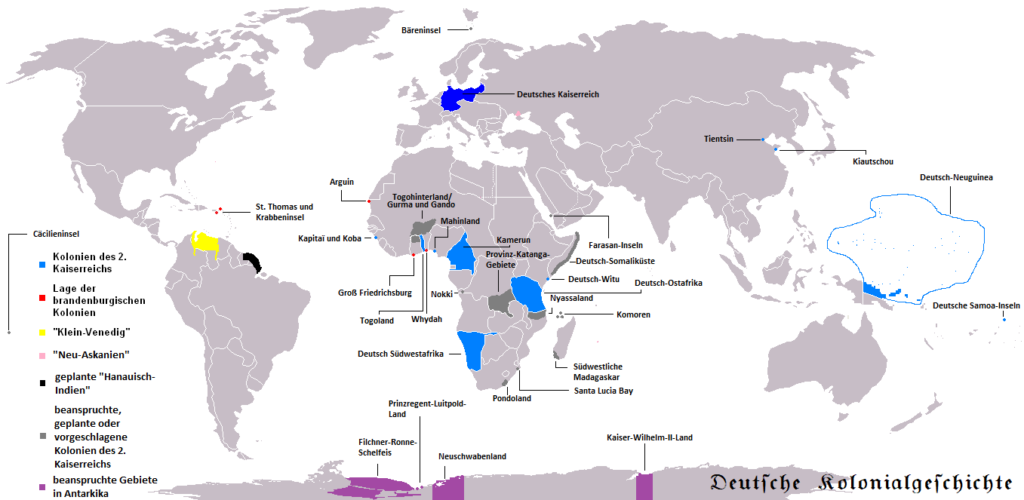
German colonial Empire in 1914
Development
Fürst Bismarck was designed before the naval arms race between Germany and the United Kingdom. Admiral Hollmann, State Secretary of the Naval Office was perfectly aware of the total dominance of the British Royal Navy and it was just assumed impossible to compete. Hollmann instead looked towards asymmetric naval warfare and vowed for a fleet of torpedo boats and coastal defense ships to defend German waters. A complement of cruisers needed to be provided for overseas duties and trade protection. However after Frederick III succeeded him, to die shortly after, a young Wilhelm II started his long reign. He had a more liberal political course in mind. Before competing with the RN he wanted at least a colonial empire and a fleet capable to defend it. Cruisers, which had long range and and a good armament to face anything that was lower than a battleline, seemed ideal.
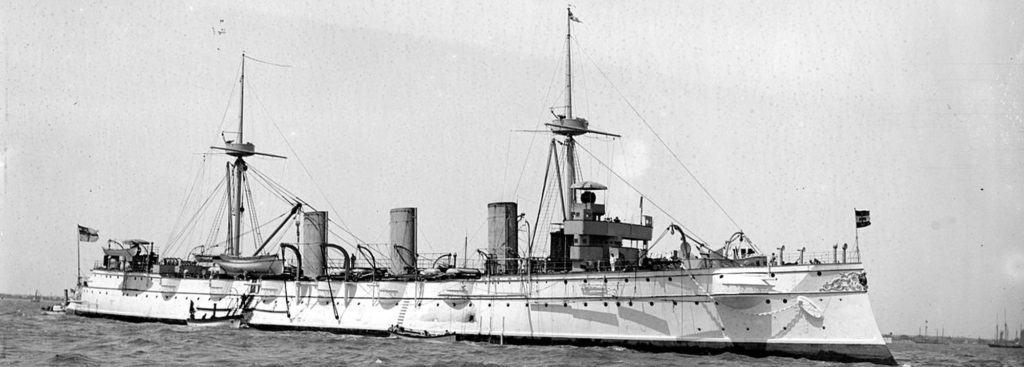
SMS Kaiserin Augusta (1890)
Efforts were made in the 1880s to transition from what was basically glorified masted gunboats to real cruisers. The year 1897 was important, as Admiral Alfred von Tirpitz came onboard as state secretary of the German Imperial Naval Office. He devised a rather practical, but still ambitious plan naval plan. He theorized this new force, albeit not capable of facing the RN, at least its existence would force Great Britain to agree to diplomatic compromises. Tirpitz started in 1898 with full support of Kaiser Wilhelm.
But the Fürst Bismarck was designed before these reforms and was the last of its kind and can be seen now largely as a transitional vessel. As the first “true” armored cruiser to be designed by the German navy, Fürst Bismarck was largely based on the previous Victoria Louise-class cruisers. It had a forecastle for seakeeping in the north sea, nearly twice the displacement, better range, speed, armour, and a more powerful armament. This was the first cruiser specifically design to stand-guard and defend German colonies in the Asia-Pacific theater. There was heavy political opposition nevertheless, linked to the idea of a colonial empire as well, but the new ship was approved by the Reichstag 1896.
Design
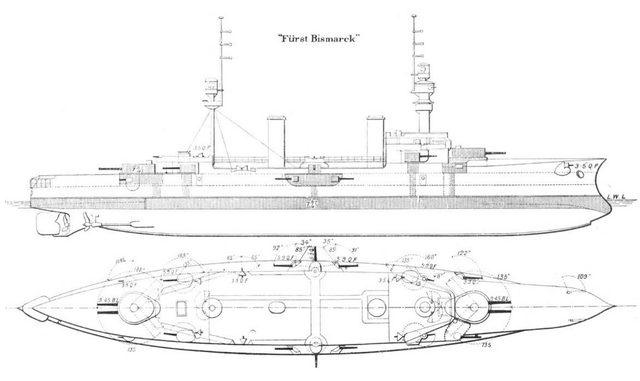
Compared to the Victoria Luise class, built at the same time, the new cruiser displaced double, at 10,690 t and 11,461 t fully loaded versus 5,660-5,885 t. standard. This traduced by larger dimensions of course, less in length a 127 m versus 110, but in beam at 20.40 m versus 17 m. The draft was also sensibly deeper. Power-wise, more generous dimensions helped to stack 12 water-tube boilers of a larger type, for an increase from 10,000 to 13,500 shp, still on three shafts. Top speed was about the same, some of the Luise class were even faster, 19.7 knots versus 18.7. On range, the previous ships were limited to 3,412 nmi (6,319 km; 3,926 mi) at 12 knots, better than the Fürst Bismarck’s 3,230 nmi (5,980 km). Cruise speed was thus reduced to 10 knots. Overall, the larger dimensions mostly help getting a better armament and protection.
Her hull comprised transverse and longitudinal steel frame, but the internal construction comprised a single layer of wooden planks, covered by a Muntz metal sheath. It extended 0.95 m (3.1 ft) above the waterline while lower portions, from stem to stern were covered with bronze plating.
Powerplant
Fürst Bismarck’s powerplant was rather traditional, and on three shafts. Each was driven by a vertical four-cylinder, triple-expansion engine, and each was fed by four Thornycroft boilers built under license by Germaniawerft, for a part, and the remainder eight had cylindrical boilers. The Thornycroft boilers were divided each into two fire boxes, and the cylindrical boilers had four making for a grand total of 32 boilers. The shafts passed this power to three-bladed screw propeller, the centerline 4.40 m (14.4 ft) in diameter, and outer ones 4.80 m (15.7 ft). Total output as indicated was 13,500 indicated horsepower (10,100 kW), procuring 18.7 knots (34.6 km/h; 21.5 mph) as designed, but on trials, output reached 13,622 ihp but for the same speed. Electrical power came from five generators for a total of 325 kilowatts at 110 volts. In general, SMS Fürst Bismarck was an excellent ood sea-boat due to its elegant clipper-ram bow, and very responsive to commands from the helm. She was taller however and therefore, with a 0.72 m (2 ft 4 in) metacentric height she had important roll problems plus heavy vibration at top speed.
Armament
SMS Fürst Bismarck’s comprised main, secondary and light guns, plus torpedo tubes; a classic combination. Main armament comprised four 24 cm (9.4 in) SK L/40 guns in twin turrets fore and aft of the superstructure, mounted in Drh.L. C/98 turrets. Elevation ranged from -5° tos 30°, achieving a range of 16,900 meters (18,500 yd). Sheels carried weighted 140-kilogram (310 lb), exiting the barrels at 835 meters per second (2,740 ft/s). 312 rounds in all were stored, 78 shells per gun.
The secondary armament comprised twelve 15 cm (5.9 in) SK L/40 quick-firing guns. They were placed in MPL type broadside casemates. They fired an armor-piercing shell, at an average rate of 4 to 5 per minute. 2,160 shells were carried in all, 120 per gun. Depression coul be as low as −7°, elevation +20° and best range 13,700 m (14,990 yd). Not a large difference with the main guns.
These AP shells weighted 51 kg (112 lb) and their muzzle velocity was 735 m/s (2,410 ft/s), control manual (mechanical) whereas it was of course assisted for the heavy 9.4 in guns.
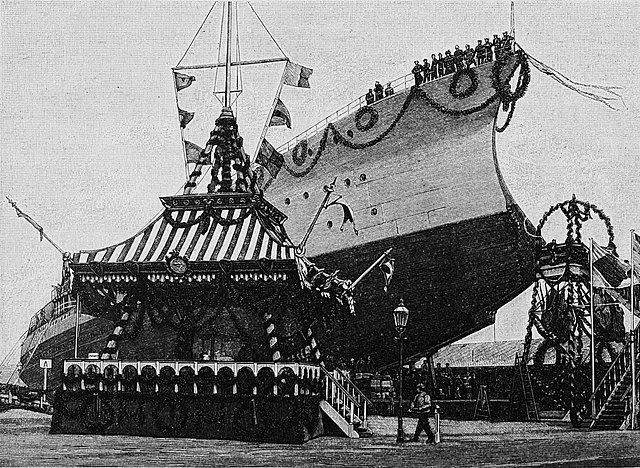
Launch of Fürst-Bismarck in 1897, unlucky she was repaired, delaying her commission
Also ten 8.8 cm (3.5 in) SK L/30 guns were installed for some in individual casemates and the rest on decks, placed on pivot mounts. They fired 7.04 kg (15.5 lb) shells at 590 m/s (1,900 ft/s) and their rate of fire was 15 shells a minute, with a range of 6,890 m (7,530 yd), with manual operation.
To complete this, the Fürst Bismarck was given six 45 cm (17.7 in) torpedo tubes, with 16 torpedoes in reserve. One of these tube was placed on a swivel mount at the stern of the ship and could be reloaded from there, while the four others were fixed and submerged on the broadside. The sixth one at the bow, was submerged.
Armour protection
SMS Fürst Bismarck was given Krupp armor for all her platings, and thicker than on the Victoria Luise class.
-Armor belt: 20 cm (7.9 in) beteween barbettes, tapered down to 10 cm (3.9 in) on the ends.
-Additional plating: 10 cm (3.9 in) over critical areas.
-Main armored deck: 3 cm (1.2 in), 5 cm (2.0 in) slopes.
-Forward conning tower: 20 cm walls, 4 cm (1.6 in) roof
-Aft conning tower: 10 cm walls, 3 cm roof.
-Main battery turret: Front and sides: 20 cm, roof 4 cm.
-15 cm turrets: 10 cm front and sides
-Gun shields: 7 cm (2.8 in).
-Casemates: 10 cm shields.
The following Prinz Heinrich was faster, but this was paid by a much thinner armour scheme, and this went on until the Blücher.
To help disseminate and contain ASW blasts, from torpedo and mines, the lower hull was divided into 13 watertight compartments, and completed by a double bottom running on 60% of the length.
Fürst Bismarck Specifications |
|
| Dimensions | 127 x 20.4 x 7.8 m (416 oa x 66 x 25 ft) |
| Displacement | 10,690 t standard, 11,461 FL |
| Crew | 36 officers, 585 ratings |
| Propulsion | 3 shafts, 12 boilers, 3 VTE engines 13,500 ihp (10,100 kW) |
| Speed | 18.7 knots (34.6 km/h; 21.5 mph), Range: 3,230 nm (5,980 km)/12kts |
| Armament | 2×2 24 cm (9.4 in), 12 × 15 cm (5.9 in), 10 × 8.8 cm (3.5 in) SK L/30, 6 × 45 cm (18 in) TTs |
| Armor | Belt: 20 cm (7.9 in), Turrets: 20 cm (7.9 in), Deck: 3 cm (1.2 in) |
Read More:
deutsche-schutzgebiete.de/wordpress/projekte/kaiserliche-marine/seiner-majestaet-schiffe/s-m-s-fuerst-bismarck/
en.wikipedia.org/wiki/SMS_F%C3%BCrst_Bismarck
Friedman, Norman (2011). Naval Weapons of World War One: Guns, Torpedoes, Mines and ASW Weapons of All Nations, Seaforth Publishing.
Gardiner, Robert & Gray, Randal, eds. (1985). Conway’s All the World’s Fighting Ships, 1906–1921.
Grießmer, Axel (1999). Die Linienschiffe der Kaiserlichen Marine: 1906–1918; Bernard & Graefe Verlag.
Gröner, Erich (1990). German Warships: 1815–1945. Vol. I: Major Surface Vessels. Naval Institute Press.
Hildebrand, Hans H.; Röhr, Albert & Steinmetz, Hans-Otto (1993). Die Deutschen Kriegsschiffe (Band 3) Ratingen: Mundus Verlag.
Padfield, Peter (1974). The Great Naval Race. Edinburg: West Newington House.
The Model Corner:
At least one: By NNT Modell+Buch of the cruiser in 1906, 1:700
The Fürst Bismarck in service
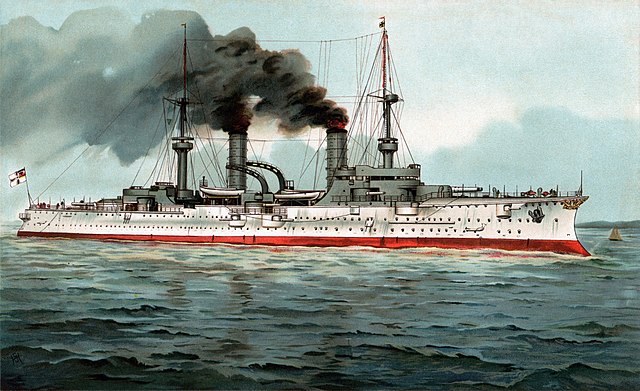
1900: The Boxer Rebellion
Launched at Kaiserliche Werft on 25 September 1897, the new cruiser was completed on 2 March 1900. However at that stage, the ironclad Sachsen accidentally collided with her, and her stern was damaged, imposing repairs. Sea trials only started from 19 March, revealing alterations were needed, but the Boxer Rebellion in China prevented this, and Fürst Bismarck was sent to the East Asia Squadron, departing Kiel on 30 June, refuelling at Gibraltar, Port Said, Port Tewfik, souther Suez Canal, Perim (Red Sea) and went through the Indian Ocean, Colombo, Ceylon and at last Singapore on 4 August. This was the crew’s own inaugural training cruise.
She escorted there the troop transport steamers Frankfurt and Wittekind, up north to Tsingtao, the main German naval base in the Kiautschou Bay concession, arriving on 13 August. Vizeadmiral Emil Felix von Bendemann took command of the East Asia Squadron and left SMS Hertha for Fürst Bismarck. He had under command also the cruisers Hansa, Kaiserin Augusta, and Irene, plus the unprotected Gefion and Seeadler. At Hong Kong, the Detached Division consisted in the four Brandenburg class battleships and the aviso Hela used as troop ships; and later reinforcements arrived, the Geier, Schwalbe, and Bussard plus the gunboats Luchs and Tiger, three torpedo boats of the S90 class and a hospital ship, Gera. In total the German Navy sent 24 warships and 17,000 soldiers, about a tenth of the massive 250 warships and 70,000 soldiers from the combined eight nations force. The commander, Bendemann, decided to blockade the Yangtze, and Fürst Bismarck, Gefion, Irene, and Iltis made the line. After the seizure of Peitsang and other harbors, Bendemann attacked Shanhaiguan and Qinhuangdao which surrendered. On 5 October, Fürst Bismarck arrived off Taku with SMS Hertha, Hela, Brandenburg, and Kurfürst Friedrich Wilhelm.
East Asia Squadron 1901-1904
In February 1901, the fight was nearly over and the East Asia Squadron resume normal duties. Fürst Bismarck visited Japanese ports with SMS Geier and two TBs by mid-1901. In September she visited Port Arthur and later returned in Japan for a shipyard maintenance in Nagasaki. Reports said then her stern was frequently leaking. The German army and navy gained quite an experience from this far away massive projection of power, underlying the need for logistics and an important network. As Germany did not hold many ports or colonies there, a maritime transport department was created in the Reichsmarineamt in 1902. Fürst Bismarck departed Japan on 15 January 1902, meeting the next month Hertha and Bussard in Singapore. Bendemann was replaced as squadron commander by Vice-Admiral Richard Geissler. Thetis joined the squadron later, but Kaiserin Augusta left with two TBs. In April, Schwalbe, Geier, and Luchs were sent to Ning Po, protecting Europeans. Fürst Bismarck was kept the flagship of the squadron which toured East Asian ports goind west to the Dutch East Indies, with training exercises in between. Tsingtao and Japan were main maintenance portas. Schwalbe left for Germany September, replaced by Geier and on 25 December, the Schießpreis (Shooting Prize) was awarded for excellent gunnery to Fürst Bismarck, representing the squadron. In early 1903, Fürst Bismarck was based in the Yangtze with Hansa and Thetis before returning to Tingtao in April, doing exercises until May, and touring Japan, hosting at one occasion the Emperor Meiji and his staff. She visited the Russian Pacific Fleet in Vladivostok by August and in November, the squadron had a new commander, Counter-Admiral Curt von Prittwitz und Gaffron.
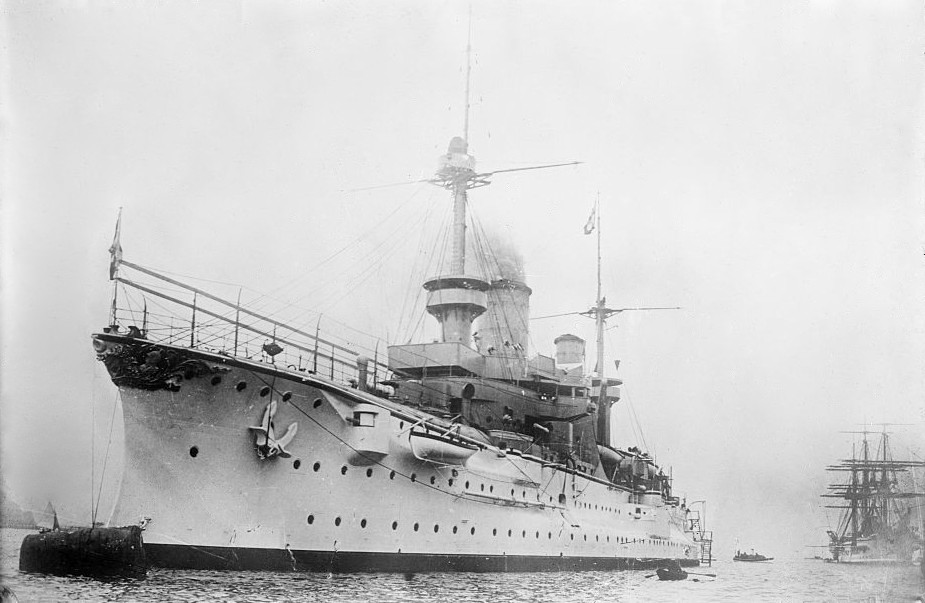
The Russo-Japanese war
After her maintenance, Fürst Bismarck went on with ports visits and exercizes in 1904, while tensions grew between Russia and Japan over Korea. On 7 January, the Admiralstab instructed Prittwitz und Gaffron to observe a strict neutrality in the area. SMS Hansa evacuated German speaking citizens from Port Arthur and Dalny as a precaution. Japan eventually severed diplomatic relations with Russia on 5 February, and so the Russo-Japanese started. On 12 February, Hansa returned to Port Arthur to evacuate the last civilians. After the Battle of the Yellow Sea on 10 August 1904, Some damaged Russian ships ended in Tsingtao, like Tsesarevich and Novik, interned until the end of the war while Fürst Bismarck and the East Asia Squadron enforced this internment, destroying Russian naval mines in between, as some could migrate into German commercial lanes. By early 1905, riots erupted in China so the squadron remained in Tsingtao until March. The Russian Second Pacific Squadron passed the colony to be later destroyed in the Battle of Tsushima. By the summer, Seeadler and Thetis left the squadron to reinforce the German East Africa and suppress a rebellion. In August Tsing Tao’s floating dry dock helped repair Fürst Bismarck in October. By November, Alfred Breusing became the new squadron commander, and in December the latter departed for a goodwill tour of southern East Asia, before heading to Shanghai to safeguard Europeans interests there as a new riot started. She even sent a landing party ashore, amalgamated with those of Jaguar, Tiger, and Vaterland. They patrolled the city cente and guarded the German consulate.
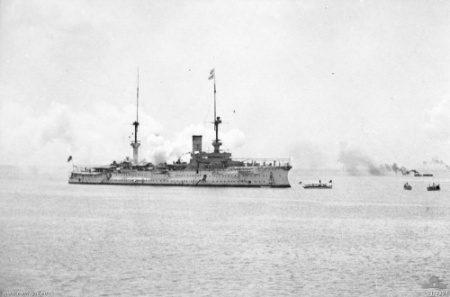
Fürst Bismarck in Manila
1906-1908 East Asia Sqn Service
In January 1906, Fürst Bismarck sailed for Indonesia, and Hong Kong before returning in March to the squadron Shanghai, which departed. Fürst Bismarck and Hansa were the only ships left in the squadron at that time. They toured Japan in May, and return to Taku, and entered the Yangtse for a cruiser up to Peking. Naval officers visited the Guangxu Emperor and Empress Dowager Cixi. Later Hansa returned to Germany on 4 July, replaced by the light cruiser Niobe. In November, Leipzig also arrived to give the squadron a three cruisers force. Fürst Bismarck and Tiger made another tour of Indonesia and Japan in 1907 and a new commander arrived, Counter-Admiral Carl von Coerper. Nothing much happened and Fürst Bismarck was awarded again a prize for marksmanship in gunnery exercises. Arcona joined the squadron on 23 October, for a total strenght of four cruisers. By January 1908, Fürst Bismarck made a state visit to Siam, hosting the King at this occasion. By early 1909 at last, the heavy cruiser was ordered to proceed to Germany for a complete overhaul after nine years of intense service that a floating drydock could not procure. On 8 April, departed and met en route the new flagship, the armored cruiser Scharnhorst in Colombo. Fürst Bismarck arrived in Kiel on 13 June.
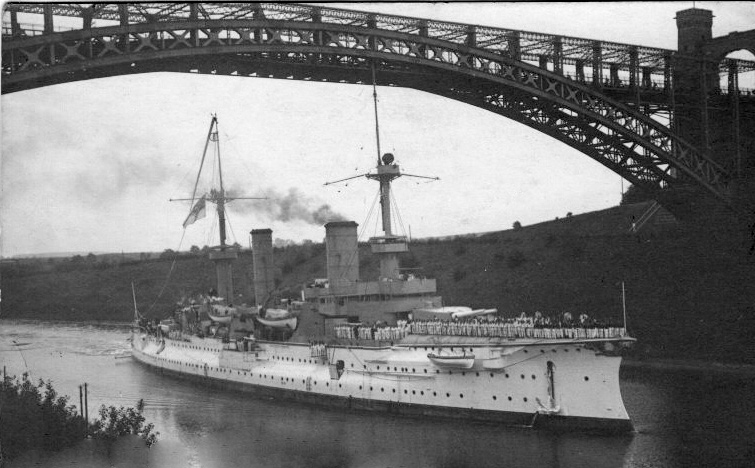
SMS Furst Bismarck in the Kiel Canal
WW1 years
In 1910, Fürst Bismarck entered Kaiserliche Werft, Kiel after an extensive modernization. The naval staff knew the ship was ageing in its role and wanter to convert her as a torpedo training ship, replacing the old ironclad Württemberg. The heavy fighting masts were replaced by light poles, the two aft-most 15 cm casemate guns removed, along many other modifications. This did not have full priority, so this work lasted for four years. She was completed indeed in July 1914. On 28 November 1914 she was recommissioned, her last captain being Ferdinand Bertram, former head of the artillery school. She made her post-refit sea trials, but by the staff not assigned her to a semi-reserve status: She was allocated to the Ist Marine Inspectorate in Kiel, with a skeleton crew, use as training ship. On 6 September 1916 she was disarmed but still operated as training ship in 1917 for commanders of the large U-Kreuzer and zeppelins for coordination. She was eventually decommissioned for good 31 December 1918 but not stricken before mid-1919. A floating office until May, stricken on 17 June she was sent to the Reichswerft in Kiel, sold to a Dortmund company, BU 1919–1920 in Rendsburg-Audorf.
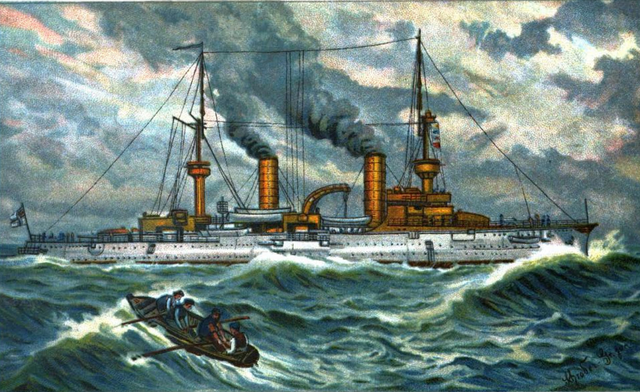
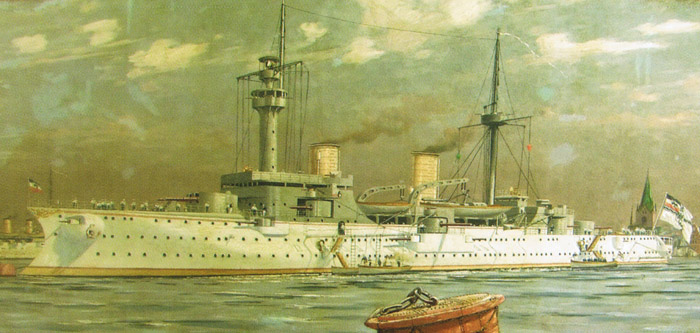
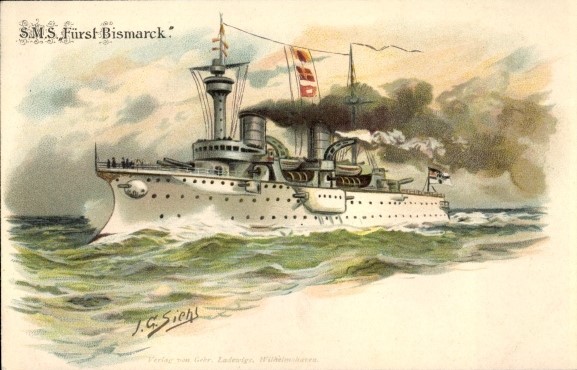

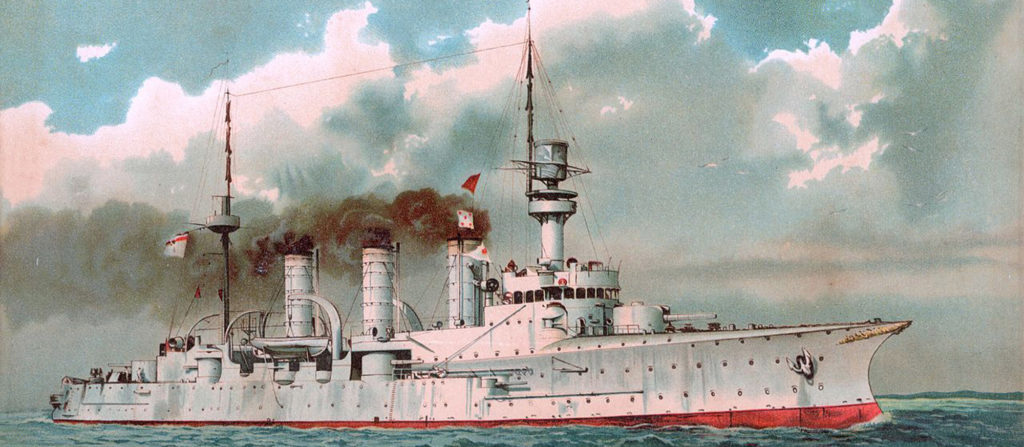
 Latest Facebook Entry -
Latest Facebook Entry -  X(Tweeter) Naval Encyclopedia's deck archive
X(Tweeter) Naval Encyclopedia's deck archive Instagram (@navalencyc)
Instagram (@navalencyc)





 French Navy
French Navy Royal Navy
Royal Navy Russian Navy
Russian Navy Armada Espanola
Armada Espanola Austrian Navy
Austrian Navy K.u.K. Kriegsmarine
K.u.K. Kriegsmarine Dansk Marine
Dansk Marine Nautiko Hellenon
Nautiko Hellenon Koninklije Marine 1870
Koninklije Marine 1870 Marinha do Brasil
Marinha do Brasil Osmanlı Donanması
Osmanlı Donanması Marina Do Peru
Marina Do Peru Marinha do Portugal
Marinha do Portugal Regia Marina 1870
Regia Marina 1870 Nihhon Kaigun 1870
Nihhon Kaigun 1870 Preußische Marine 1870
Preußische Marine 1870 Russkiy Flot 1870
Russkiy Flot 1870 Svenska marinen
Svenska marinen Søværnet
Søværnet Union Navy
Union Navy Confederate Navy
Confederate Navy Armada de Argentina
Armada de Argentina Imperial Chinese Navy
Imperial Chinese Navy Marinha do Portugal
Marinha do Portugal Mexico
Mexico Kaiserliche Marine
Kaiserliche Marine 1898 US Navy
1898 US Navy Sovietskiy Flot
Sovietskiy Flot Royal Canadian Navy
Royal Canadian Navy Royal Australian Navy
Royal Australian Navy RNZN Fleet
RNZN Fleet Chinese Navy 1937
Chinese Navy 1937 Kriegsmarine
Kriegsmarine Chilean Navy
Chilean Navy Danish Navy
Danish Navy Finnish Navy
Finnish Navy Hellenic Navy
Hellenic Navy Polish Navy
Polish Navy Romanian Navy
Romanian Navy Turkish Navy
Turkish Navy Royal Yugoslav Navy
Royal Yugoslav Navy Royal Thai Navy
Royal Thai Navy Minor Navies
Minor Navies Albania
Albania Austria
Austria Belgium
Belgium Columbia
Columbia Costa Rica
Costa Rica Cuba
Cuba Czechoslovakia
Czechoslovakia Dominican Republic
Dominican Republic Haiti
Haiti Hungary
Hungary Honduras
Honduras Estonia
Estonia Iceland
Iceland Eire
Eire Equador
Equador Iran
Iran Iraq
Iraq Latvia
Latvia Liberia
Liberia Lithuania
Lithuania Mandchukuo
Mandchukuo Morocco
Morocco Nicaragua
Nicaragua Persia
Persia San Salvador
San Salvador Sarawak
Sarawak Uruguay
Uruguay Venezuela
Venezuela Zanzibar
Zanzibar Warsaw Pact Navies
Warsaw Pact Navies Bulgaria
Bulgaria Hungary
Hungary

 Bundesmarine
Bundesmarine Dutch Navy
Dutch Navy Hellenic Navy
Hellenic Navy Marina Militare
Marina Militare Yugoslav Navy
Yugoslav Navy Chinese Navy
Chinese Navy Indian Navy
Indian Navy Indonesian Navy
Indonesian Navy JMSDF
JMSDF North Korean Navy
North Korean Navy Pakistani Navy
Pakistani Navy Philippines Navy
Philippines Navy ROKN
ROKN Rep. of Singapore Navy
Rep. of Singapore Navy Taiwanese Navy
Taiwanese Navy IDF Navy
IDF Navy Saudi Navy
Saudi Navy Royal New Zealand Navy
Royal New Zealand Navy Egyptian Navy
Egyptian Navy South African Navy
South African Navy






























 Ukrainian Navy
Ukrainian Navy dbodesign
dbodesign